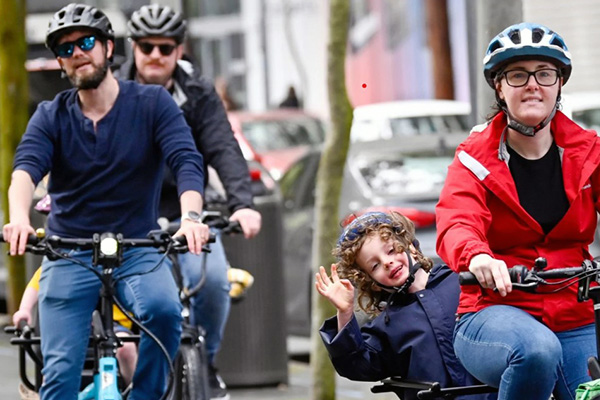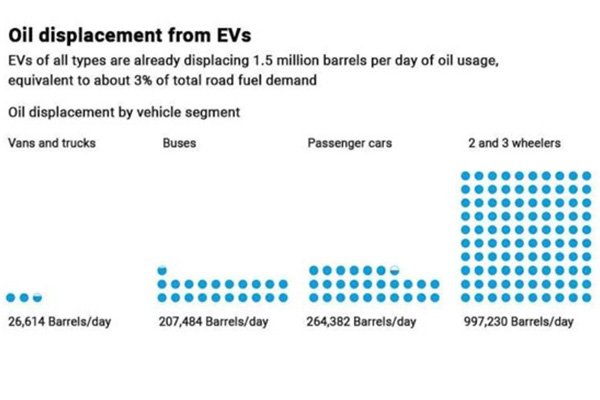Over the next two years Tasmanians will be offered $1.2 million dollars in incentives to buy e-bikes, e-scooters, and e-vehicles. This is part of the Tasmanian Government’s Climate Change Action Plan. Options for delivering the e-bike program include try-before-you-buy schemes, assistance to buy, and direct subsidies. The form the subsidies will take, according to The Micromobility Report, will be outlined in November. Tasmania is the first Australian State to be offering such a scheme.
The hope is that other states will follow!
E-bikes make riding for transport accessible, convenient and fun (Credit: Lug + Carrie)
“The action plan also commits the Government to ongoing collaboration with local governments to improve active transport infrastructure, as well as updating the Tasmanian Walking and Cycling for Active Transport Strategy.” Micromobility Report.
A policy no-brainer with zero downside
The City of Sydney’s Try an E-bike series of events have proven very popular. People have had the opportunity to try e-bikes from Lekker, Lug+Carrie and Omafiets. (Credit: City of Sydney)
Apart from Tasmania, Australian states are stuck behind the wheel
As the world embraces micromobility (human-powered transport), Australian states remain wedded to car-based planning. Indeed, our relationship with the car has been ingrained into decades of policy. Although we love cars, for the majority of short trips, they’re largely unnecessary. And our dependence upon them has left us poorer and unhealthy. Every day 6 million trips shorter than 5 km are driven in Greater Sydney. And over 2 million of these are less than 2 km. But across Europe and the United States, governments at every level have opened the floodgates to e-bike subsidies-
The world has moved on and is reaping the rewards
- There are almost 300 tax-incentive and purchase-premium schemes for cycling across Europe offered by national, regional and local authorities.
- France’s government offers up to €4,000 (approx. $6, 617) to ditch your car for a bike or e-bike. Paris’s Mayor also promised to add another 130 kilometres of cycleways over 5 years.
- Meanwhile, the Biden Administration has passed the Electric Bicycle Incentive Kickstart for the Environment Act. The E-BIKE Act offers a 30% tax credit for purchasing an electric bicycle. And up to a $1500 credit for new bicycles less than $8000.
Lithuanian bike riders receive €700 ($1,157.99) in bike and e-bike subsidies. For the full rundown go to the European Cyclists Federation online tool. (Credit ECF)
The best EVs have two wheels
Cost of living: E-bikes are between 10-40 times cheaper than EVs which drives the subsidy dollar further. It also makes them widely available rather than just benefiting an exclusive minority of new car owners. This then means more people riding, less driving and a faster route to decarbonising the network. It also massively alleviates cost of living pressure by providing a cheap, healthy alternative to car dependence.
Decarbonisation: E-bikes are 40 times less carbon-intensive to produce and draw a fraction of the electricity required to power an EV. The National EV strategy estimates that it will take 10 years to fully commission a national EV fleet. This includes building a used EV market. But subsidised e-bikes can be rolled out as soon as the policy is hammered out.
Micromobility displaces more barrels of oil each day than all the other electrified transport modes combined (From: Anthropocene August 23)
Reduced traffic congestion: The average car (ICE or EV) takes up the space of 8 bicycles. And for short trips and the majority of deliveries, standard vehicles cannot compete. This is because one e-cargo bike connected to a logistics hub can make 8-10 times more trips than a truck battling through traffic. They’re also way safer in densely populated areas.
Healthy people and streets: Australia’s legacy of car-based planning has resulted in a deadly urban environment. To illustrate, just last year 1194 Australians were killed on our roads. And physical inactivity is through the roof with 25% of children and 67% of adults regarded as overweight/ obese. In addition, only 14% of Australian kids walk or cycle to school. This ranks them 140th out of the 146 least active nations on Earth.
“Walking, wheeling, scooting and all forms of active transport need to be encouraged through subsidies and programs,” says Peter McLean, Bicycle NSW CEO. "In order to tackle massive health and environmental challenges, active transport needs to take its rightful place. At the moment it is subordinate to car-first planning and we’re paying a hefty price.”
Bicycle subsidies go hand in hand with safe infrastructure, protected from roads which is why we need your support. (Credit: City of Sydney)
Come on NSW! Subsidise e-bikes now!
“In a cost of living crisis, car-related expenses are through the roof,” says Peter McLean. “Yet people are being discouraged from walking and cycling due to lack of decent infrastructure. The NSW Government has committed to delivering a 70% emissions cut by 2035. But there’s no way $633 million dollars budgeted for EV subsidies and infrastructure will reach Net Zero in time. This is because the roll out will take 10 years and will only benefit a few. Big EVs won’t make our roads any safer or transport more efficient. Nor do they encourage physical activity. So, we need an EV subsidy program that’s fair for all and designed to achieve its goal.”
This is why we’re saying: e-bike subsidies now, and better infrastructure for active travel.
Just one more thing
Not only do we have the best bicycle insurance, but Bicycle NSW has been actively campaigning for 47 years in NSW for better infrastructure for bike riders of all ages and abilities. Join us now and support our campaign for Better Streets.






